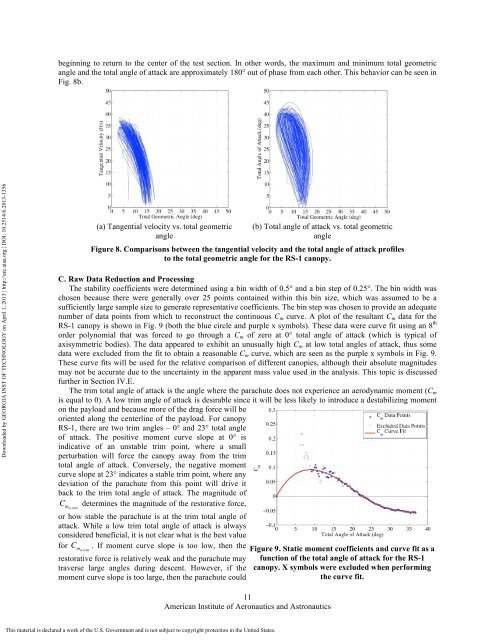Aerodynamic Stability and Performance of Next-Generation ...
Aerodynamic Stability and Performance of Next-Generation ...
Aerodynamic Stability and Performance of Next-Generation ...
You also want an ePaper? Increase the reach of your titles
YUMPU automatically turns print PDFs into web optimized ePapers that Google loves.
eginning to return to the center <strong>of</strong> the test section. In other words, the maximum <strong>and</strong> minimum total geometric<br />
angle <strong>and</strong> the total angle <strong>of</strong> attack are approximately 180° out <strong>of</strong> phase from each other. This behavior can be seen in<br />
Fig. 8b.<br />
Downloaded by GEORGIA INST OF TECHNOLOGY on April 1, 2013 | http://arc.aiaa.org | DOI: 10.2514/6.2013-1356<br />
(a) Tangential velocity vs. total geometric<br />
angle<br />
C. Raw Data Reduction <strong>and</strong> Processing<br />
The stability coefficients were determined using a bin width <strong>of</strong> 0.5° <strong>and</strong> a bin step <strong>of</strong> 0.25°. The bin width was<br />
chosen because there were generally over 25 points contained within this bin size, which was assumed to be a<br />
sufficiently large sample size to generate representative coefficients. The bin step was chosen to provide an adequate<br />
number <strong>of</strong> data points from which to reconstruct the continuous C m curve. A plot <strong>of</strong> the resultant C m data for the<br />
RS-1 canopy is shown in Fig. 9 (both the blue circle <strong>and</strong> purple x symbols). These data were curve fit using an 8 th<br />
order polynomial that was forced to go through a C m <strong>of</strong> zero at 0° total angle <strong>of</strong> attack (which is typical <strong>of</strong><br />
axisymmetric bodies). The data appeared to exhibit an unusually high C m at low total angles <strong>of</strong> attack, thus some<br />
data were excluded from the fit to obtain a reasonable C m curve, which are seen as the purple x symbols in Fig. 9.<br />
These curve fits will be used for the relative comparison <strong>of</strong> different canopies, although their absolute magnitudes<br />
may not be accurate due to the uncertainty in the apparent mass value used in the analysis. This topic is discussed<br />
further in Section IV.E.<br />
The trim total angle <strong>of</strong> attack is the angle where the parachute does not experience an aerodynamic moment (C m<br />
is equal to 0). A low trim angle <strong>of</strong> attack is desirable since it will be less likely to introduce a destabilizing moment<br />
on the payload <strong>and</strong> because more <strong>of</strong> the drag force will be<br />
oriented along the centerline <strong>of</strong> the payload. For canopy<br />
RS-1, there are two trim angles – 0° <strong>and</strong> 23° total angle<br />
<strong>of</strong> attack. The positive moment curve slope at 0° is<br />
indicative <strong>of</strong> an unstable trim point, where a small<br />
perturbation will force the canopy away from the trim<br />
total angle <strong>of</strong> attack. Conversely, the negative moment<br />
curve slope at 23° indicates a stable trim point, where any<br />
deviation <strong>of</strong> the parachute from this point will drive it<br />
back to the trim total angle <strong>of</strong> attack. The magnitude <strong>of</strong><br />
C mα,trim<br />
determines the magnitude <strong>of</strong> the restorative force,<br />
or how stable the parachute is at the trim total angle <strong>of</strong><br />
attack. While a low trim total angle <strong>of</strong> attack is always<br />
considered beneficial, it is not clear what is the best value<br />
for C mα,trim<br />
. If moment curve slope is too low, then the<br />
restorative force is relatively weak <strong>and</strong> the parachute may<br />
traverse large angles during descent. However, if the<br />
moment curve slope is too large, then the parachute could<br />
(b) Total angle <strong>of</strong> attack vs. total geometric<br />
angle<br />
Figure 8. Comparisons between the tangential velocity <strong>and</strong> the total angle <strong>of</strong> attack pr<strong>of</strong>iles<br />
to the total geometric angle for the RS-1 canopy.<br />
Figure 9. Static moment coefficients <strong>and</strong> curve fit as a<br />
function <strong>of</strong> the total angle <strong>of</strong> attack for the RS-1<br />
canopy. X symbols were excluded when performing<br />
the curve fit.<br />
11<br />
American Institute <strong>of</strong> Aeronautics <strong>and</strong> Astronautics<br />
This material is declared a work <strong>of</strong> the U.S. Government <strong>and</strong> is not subject to copyright protection in the United States.
















